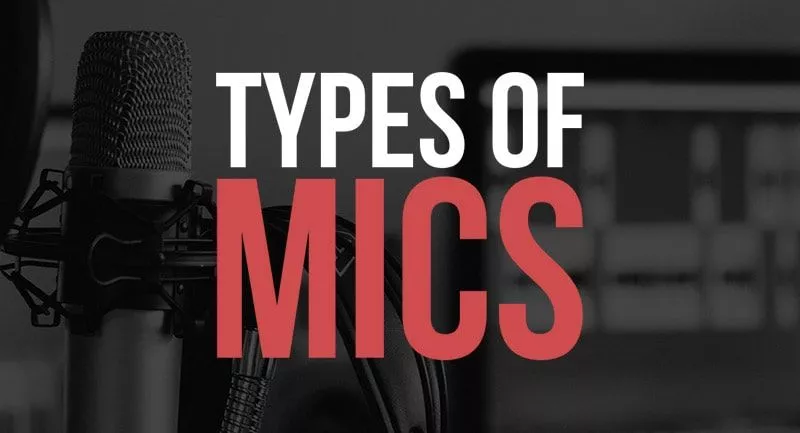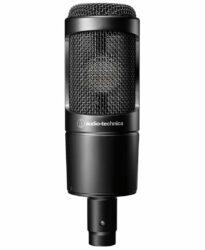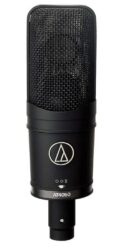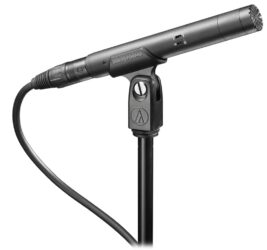This guide will explain the different types of microphones, how they are used, and what type of microphone you should use for your projects.
Microphones are instruments that take sound as an input and convert it into a signal so that it can be transmitted or recorded. There are many different types of microphones, and each one has its own unique characteristics and design.
- Types of Microphones
- What Are The 3 Main Microphones
- Which Type of Mic Is Best For Vocals
- What Microphone Is Best For Instruments
- Mics Best For Live Performances
- Which Microphone Is Best For YouTube
- Top Selling Microphones
What Are The Different Types of Microphones?
There are many different types of microphones available on the market. Each type of microphone has its own unique characteristics and is designed for a specific job.
Check out the list below to see what different types of microphones exist.

1. Cardioid Microphones

Cardioid microphones are the most common type of microphone and tend to be very sensitive. This is because it has a pronounced unidirectional pickup pattern.
Unidirectional means that it has a narrow pickup area with blocking in the back, so when you speak directly into the microphone, it will only pick up the sound directly in front of the mic. This has a few benefits, such as noise-canceling and reduction.
Singers, podcasters, and speakers mostly use cardioid microphones for live performances. It is also the go-to microphone to record vocals.
2. Dynamic Microphones
Dynamic microphones are one of the most common microphones on the market. They are typically very durable and can handle high sound pressure levels.
Dynamic microphones are also easy to use because they don’t require phantom power. They are the best choice for live musicians, drummers, and guitarists.
3. Condenser Microphones

Condenser microphones are known for their high sensitivity and excellent frequency response. They are very responsive to transients, which means they have fast rise times.
Condenser microphones are typically bulkier than other types of microphones because of the internal electronics that enable them to capture a wide range of frequencies.
Condenser microphones can be divided into two categories:
Related: What is a Condenser Microphone
3.1 Small Diaphragm Condensers
Small-diaphragm condenser microphones are very popular as drum overheads and room mics. Because of their small size, they can be placed in tight or awkward places.
Many engineers use them to record vocals because they offer great off-axis sound rejection.
3.2 Large Diaphragm Condensers
Large-diaphragm condenser microphones are great for recording instruments producing high sound pressure levels. These microphones can handle loud and powerful signals and still provide excellent fidelity.
Some engineers use them for vocals because they have a friendly, warm tone.
Related: Best Condenser Microphones
4. Ribbon Microphones
A Ribbon mic is similar to condenser microphones in that they are collapsible and sensitive to high sound pressure levels. They produce an extremely smooth tone, which many engineers use for vocals and stringed instruments.
Ribbon mics are at a disadvantage because they need to be plugged into a special amplifier that is not built into the microphone. They also tend to be fragile.
5. Omnidirectional Microphones

Omnidirectional microphones pick up sound equally from all around the microphone. This type of mic is typically used in recording environments where ambient noise needs to be canceled out or when a stereo recording is desired.
These mics are commonly used by podcasters, live announcers, and public address systems because they provide a full 360-degree sound field.
6. Hypercardioid Microphones (Mini-Shotguns)
Hypercardioid microphones pick up a narrow sound field, thus minimizing unwanted noise. They use a cosine-like or figure-eight pickup pattern.
These microphones are typically used for film, TV, and theater because they isolate the voice while reducing background noise. They are also used for recording instruments such as drums and guitar amps because they reduce microphone bleed.
7. Supercardioid Microphones (Shotgun)
Supercardioid microphones are similar to hyper-cardioid mics, but they have a slightly better off-axis rejection. This type of mic is typically used for film, TV, and theater.
This microphone will excel if you need to isolate a voice while minimizing background noise and ambient sound.
Related: What Is A Microphone Shock Mount?
8. Handheld Field Recorders
Handheld field recorders are usually small and lightweight, with built-in stereo microphones. They often provide a wide range of recording options and capabilities, such as the ability to record sound effects, interviews, or music for video.
Field recorders typically have a built-in microphone that provides high-quality stereo sound and low noise. These are commonly used by professional journalists, sports announcers, and audio productions.
9. Multi-Pattern Mics
Multi-pattern mics are microphones that have several different patterns, typically cardioid, super-cardioid, and omnidirectional. These types of microphones are usually used in broadcast studios where it’s critical to be able to control ambient noise.
Multi-pattern mics are incredibly versatile because you can choose the pattern that best suits your needs. Broadcast studios typically use them because they allow users to switch patterns depending on their desired output.
10. USB Mics
USB mics connect to a computer or laptop via a USB connection. They are typically used for recording vocals and instruments, but they can also be used for podcasting, home studio recording, and much more.
These mics are convenient because they typically plug right into the computer without requiring additional equipment.
11. Shotgun Mics
Shotgun microphones are super cardioid mics that typically have an elongated design. These microphones excel at recording vocals, film sound, and music.
A shotgun mic is great for film and video production because it can be plugged directly into the camera, capturing high-quality sound at a distance.
12. Wireless Mics
Wireless mics are popular among musicians and public speakers because they allow users to move around freely without worrying about tripping over a cable.
Wireless mics use radio frequencies (RF) to transmit the signal from one device to another, and they come in a variety of configurations.
Wireless microphones can be very expensive and require additional receivers depending on the exact system.
Musicians use them because they allow freedom of movement, and public speakers allow users to interact more directly with their audience.
13. Boundary Mics
Boundary microphones are small mics that typically require no stand or support to record sound. They often come with adjustable clips so you can configure the mic to fit your recording environment.
These mics are excellent for recording meetings, sound effects, and ambient noise because they can easily be placed on a table or other flat surfaces.
14. Bass Mics

Bass mics are specifically designed to record the lowest frequencies. They typically feature large diaphragms and a high SPL (sound pressure level) to reduce distortion.
Churches, symphonies, and DJs often use this type of microphone because it allows them to capture the full range of their sound.
15. Boom Mics
Boom mics are typically attached to a boom stand and used for recording broadcast shows, film sets, or interviews.
They have a gooseneck design to be easily adjusted, and they typically come with a windscreen to minimize noise while recording.
These mics are great for professional audio production because they can easily adjust and position.
What Are The 3 Main Microphones?
Many types of mics are available on the market, but the three main microphones are cardioid, dynamic, and condenser.
1. Cardioid Microphones
Cardioid mics are mics with a heart-shaped pattern. These microphones have the best off-axis rejection, which means they capture the loudest sound directly in front of them while minimizing any outside noise.
Cardioid mics are popular for studio recording because they have a tight pattern and capture the clearest sound.
No products found.
2. Dynamic Microphone
Stage performers typically use dynamic mics because they are durable and have a low output impedance.
Dynamic mics are often used in live sound situations because they are very resistant to loud sounds, making them popular for singers and instrument players.
No products found.
3. Condenser Mics
Condenser microphones are sometimes referred to as capacitor microphones. These microphones have a more complex design and are typically used in professional recording studios.
Condenser mics typically produce a much brighter and fuller sound than dynamic mics because they have a more comprehensive frequency response.
This type of microphone is used for recording vocals and solo instruments because it can capture a large sound range with clarity and detail.
No products found.
Which Type of Mic Is Best For Vocals?
Vocals are best recorded using a condenser microphone to produce a bright and full sound.
Cardioid mics can be used to record vocals, but they have a tighter polar pattern, which can make it challenging to capture the full range of your voice.
Dynamic mics are typically not used for vocals because they have a lower output impedance, which can cause distortion.
Here are the top-selling vocal microphones on Amazon.
No products found.
What Microphone Is Best For Instruments?
Instruments are typically recorded using dynamic mics because they have a wide frequency response and capture low frequencies.
Condenser mics can also be used to record instruments, but they typically have a flatter frequency response and may not accurately represent the low frequencies.
What Type Of Mic Is Best For Live Performances?
Deciding what type of microphone to use for live performances can vary depending on your situation.
A dynamic mic is typically the best option if you are performing alone. If you are part of a group with both singers and instrument players, you will want to use a cardioid mic.
Which Microphone Is Best For YouTube?
YouTube videos are typically recorded using dynamic mics because they have a wide frequency response and capture low frequencies.
Condenser mics can also record YouTube videos, but they typically have a flatter frequency response and may not accurately represent the low frequencies.
No products found.
Top Selling Microphones
Here are the most popular microphones on Amazon.
No products found.
Summary of Microphones
With the vast array of microphone types, each has unique strengths that cater to different needs. Ribbon microphones, for example, are cherished for their ability to capture sound waves and deliver a more natural sound, a feature that makes them ideal for acoustic instruments.
On the other hand, dynamic microphones, including popular dynamic mics, excel at capturing louder sounds without distortion, making them a go-to choice for loud instruments.
Condenser microphones, encompassing both small diaphragm condenser microphones and large diaphragm condenser microphones, are sensitive and detailed, providing the best sound quality in the right conditions.
Specifically, large diaphragm mics are favored for their ability to produce a natural sound when recording music, while small diaphragm mics are celebrated for their precise capture of sound waves from various sound sources.
Ribbon mics, condenser mics, and dynamic mics all convert sound waves into an electrical signal, a feature central to their operation. However, condenser mics are unique in that they require an external power source, like phantom power supplied by an audio interface, due to their sophisticated design.
Microphones also vary in their polar pattern, with cardioid mics featuring a cardioid polar pattern, being highly directional and ideal for focusing on a single sound source, such as voice sounds or recording snare drums.
Lastly, modern microphones, whether dynamic or condenser microphones, continue to evolve, offering better sound quality and adaptability to both loud sound sources and acoustic guitars alike.
In conclusion, understanding the differences between ribbon, condenser, and dynamic microphone types is crucial in producing quality sound.
Whether it’s to capture the delicate sound waves of an acoustic guitar or the powerful sound pressure vibrating from loud instruments, the mic type you choose can greatly influence your sound.
Thus, having this knowledge not only equips you to make better decisions but also lets you manipulate the electrical signals created when sound waves convert sound into the most fitting, high-quality audio possible.
I hope you now understand the different types of microphones and how they are used to record audio.





The 3 types of mics are Condenser, Dynamic, and Ribbon… not cardioid. Cardioid describes the polar pattern of a particular microphone.
Thanks for the work done bt the main three types of mics are;
*Condenser
*Dynamic
*Ribbon